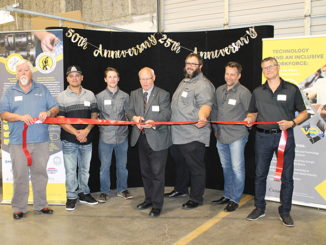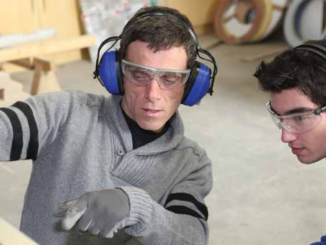The busy construction schedules of 2017 promise to run on into 2018 with no sign of a slowdown in most sectors of the BC construction industry.
With busy schedules come challenges—skilled labour, underpricing, vulnerability to regional and global economic markets are at the top of the list—and these demand innovation and tenacity among contractors in the mission to overcome.
The dawn of a new year is always a great time to think about what is coming down the pipe and plan business strategies. Sheet Metal Journal, with help and support from SMACNA-BC, launched an industry survey in December to discover what issues contractors face, how they are handling challenges and exploiting opportunities, and what kinds of changes they have planned for 2018.
Jeremy Hallman, Apollo Sheet Metal, said a lot of the work has shifted from large commercial to mixed use residential, requiring a specific workforce with a different skill set.
To adapt, the company has made some changes with how it delegates labour. “We are running more jobs with fewer tradespeople on them because residential tower work typically doesn’t require as may people,” said Hallman. “We are adapting with new foreman and a focus on maintaining a percentage of pre-apprentice and apprentices.”
Hallman adds the industry’s biggest opportunity in 2018 is the region’s fair amount of large industrial work, which may help to some degree with the labour shortage.
“This could be appealing to some of the skilled tradespeople that have typically had to travel for this type of work,” he said. “It could help to improve the overall skill set locally and make everyone more diverse.
“I think you will still have the people that would prefer to work out of town; however, I think it will help Apollo attract tradespeople that might be working locally that would rather work industrial but don’t want to leave their families and live out of town.”
Industrial work ranked highest among perceived opportunities for 2018—others included commercial buildings, expansion and growing of new markets, and diversifying operations to meet market demand.
In terms of challenges, contractors listed ensuring proper communication in the industry, keeping up with the volume of work while maintaining quality, finding qualified manpower, and training in generation Y tactics as the main stumbling blocks, while 25 per cent said they forecasted no challenges for 2018.
More than 65% of respondents said labour retention would be their primary strategy for staying competitive for the coming year.
Aaron Smith, owner of Smith Sheet Metal, is one of several survey respondents who say success in meeting most obstacles like labour and a fluctuating economy is about building and maintaining industry relationships.
Moving into 2018, Smith said the biggest opportunity for the industry will be, “a continued steady growth for companies that have been able to build and strengthen their relationships with their partners along the way. It should be a good year.”
Hallman agrees, noting that although the market dictates labour availability to some degree, companies need to be proactive in retaining their key personnel and managing their skilled labour supply.
“Anytime a company gets busy and needs to hire a lot of tradespeople at one time you are bound to get some duds,” he said. “Good people are working—because they are good. You need to provide the right environment so that they want to hire on and stay on.
“I think the type of work, stability, and the way they are treated will decide if they stay or go.”
Smith is investing in both technology and young workers while the opportunity presents.
“We are investing in both technology and young workers,” he said. “This is the time to strengthen your roots and prepare for when times are not so good again.
“Our past work force was filled with older experienced workers and now is the time to share that knowledge and prepare as best possible for the next wave of workforce.”
Even companies who have experienced a minor slowdown over the past year hinge their plans moving forward on relationship building, both internally and with external partners.
Phil McDonald, owner of Summit Sheet Metal, said his company has experienced a bit of a slowdown because of delays on a few major projects.
“We are going to be bombarded with work in spring carrying us through into next year, which is a positive except I hear we are not the only company in this boat. People power is going to be a real factor.”
The biggest opportunity in this climate will be higher profit on new jobs tendering, and justifying prices with quality and workmanship, he added.
“It comes back to relationships,” he said. “There are a lot of times where the contractor and owner will take cheaper price but will end up calling us in to fix it. That only happens for so long before people are sick of dealing with the lower quality work that comes with a low price.”
McDonald has several examples of projects on which he may not have had the lower price, but he won the tender because of this very principle.
“My price is my price and whenever someone wants to question it, we answer freely,” he said.
“It is an open book and I am happy to explain costs. People tend to understand and after a while, those questions stop.
“We give what the owners want and we are getting what need,” he said. “It doesn’t help when guys come in buy jobs and work, and that becomes the standard. There has to be some trust and communication among our industry partners.”
Tony Tesan, Summit Sheet Metal, said while there is a lot of work in the Lower Mainland, developers are still trying to keep costs down. “Competition for bids is still occurring,” he said, “and trying to keep our cost down to land contracts is still a challenge.”
Despite the challenge, Tesan doesn’t foresee a drop in the company’s workload for 2018, but does predict more workers will be required should the company end up with more work than anticipated.
A wildcard, of course, is foreign investment, dictated by regional and global markets.
“Foreign investors stimulate a large portion of the construction in the Lower Mainland,” he said. “Should something occur globally, particularly in Asia, it could greatly affect the industry and construction in general.”
Staying competitive will mean keeping an eye on productivity, he added.
“We need to ensure we are organizing men and materials to maximize productivity,” said Tesan. “Material and equipment can be a fixed cost. Labour can be a challenge if you don’t have the skilled labour.”
These values translate into the secret to resilience, especially when labour is contentious. “The answer for us to to treat our guys like an extended family, and ask them to do the same,” said McDonald.
“I always say to the guys, if you wouldn’t do it at your house, don’t do it here. Take the time to get things right,” he said. “I’ve never once had to go back on a job again [to correct faulty work].”
Summit also shares labour with other companies—a growing trend among sheet metal companies who want to retain skilled workers and build loyalty among crews. It isn’t uncommon these days for a company experiencing a slow period to “lend” workers to a competitor on an honour system with the idea they will come back when things pick up.
“Sometimes contractors don’t like it because they think they will get the short end of stick, but the worst thing you can do to someone is lay them off,” said McDonald. “If you loan them out, they still feel welcome and like family—it’s a win-win for everyone.”
Over the next five years, 10 per cent of contractors indicated they would be looking to add space or locations, the number of respondents expanding (15%), retiring (15%), or carrying along the same trajectory (15%) was equal, indicating plenty of opportunity for the 45% who plan to develop new markets over the next half decade.
McDonald’s five-year plan is simple and wise: “We will continue to build on our family atmosphere,” he said, “and surround ourselves with other companies that want to work together to keep our industry strong.”




